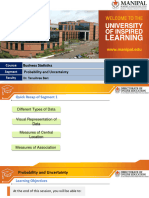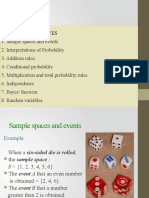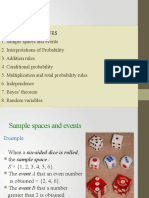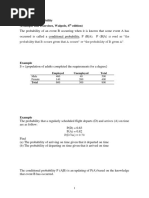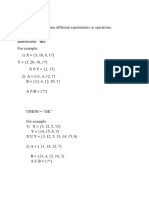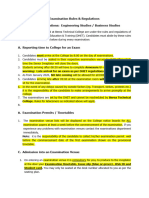0 ratings0% found this document useful (0 votes)
21 viewsExercise Probability
A car manufacturer made two models, A and B, in three colors last week. A table shows the production volumes. The probabilities of randomly selecting a red car, model B car, model B and red car, and model B or red car are calculated. The probability of selecting a black car given it is a model A car is also found. Whether selecting a model A car and black car are mutually exclusive or independent is determined by comparing joint and individual probabilities. Mutually exclusive and independent events are then defined and explained with an example.
Uploaded by
Ahmad MalakCopyright
© © All Rights Reserved
Available Formats
Download as PDF, TXT or read online on Scribd
0 ratings0% found this document useful (0 votes)
21 viewsExercise Probability
A car manufacturer made two models, A and B, in three colors last week. A table shows the production volumes. The probabilities of randomly selecting a red car, model B car, model B and red car, and model B or red car are calculated. The probability of selecting a black car given it is a model A car is also found. Whether selecting a model A car and black car are mutually exclusive or independent is determined by comparing joint and individual probabilities. Mutually exclusive and independent events are then defined and explained with an example.
Uploaded by
Ahmad MalakCopyright
© © All Rights Reserved
Available Formats
Download as PDF, TXT or read online on Scribd
You are on page 1/ 5
Probability - Example
A sport car manufacturer makes two car models, A
and B, in three distinct colors. The table below shows
the production volumes for last week:
Color
Model Blue Red Black
A 302 105 200
B 40 205 130
• What is the probability that a randomly selected car is red?
• P(red) = # red/Total = 310/982 = 0.3157
• What is the probability that a randomly selected car is a
model B?
• P(B) = #B/Total = 375/982 = 0.3819
Probability - Example
A sport car manufacturer makes two car models, A
and B, in three distinct colors. The table below shows
the production volumes for last week:
Color
Model Blue Red Black
A 302 105 200
B 40 205 130
• What is the probability that a randomly selected car is a
model B and red?
• P(B and red) = 205/982 = 0.2088
• What is the probability that a randomly selected car is a
model B or red?
• P(B or red) = P(B) + P(red) – P( B and red) =
= 0.3819 + 0.3157 - 0.2088 = 0.4888
Probability - Example
A sport car manufacturer makes two car models, A
and B, in three distinct colors. The table below shows
the production volumes for last week:
Color
Model Blue Red Black
A 302 105 200
B 40 205 130
• What is the probability that a car is black given that it is
a model A car?
• P(black | A) = 200/607 = 0.3294
• Are these events (model A is chosen and black car is
chosen) mutually exclusive?
(Two mutually exclusive events cannot occur at the same time)
• No they share outcomes (joint probability not null)
Probability - Example
A sport car manufacturer makes two car models, A
and B, in three distinct colors. The table below shows
the production volumes for last week:
Color
Model Blue Red Black
A 302 105 200
B 40 205 130
• Are these events (model A is chosen and black car
is chosen) independent?
• No because: P(black) = 330/982 = 0.2342 is not
equal to: P(black | A) = 0.3294
Mutually exclusive Vs. Independent
• Mutually exclusive events are not independent
• P(A and B) = 0
• P(A and B) = P(A) P(B)
• Or equivalently Independent events cannot be
mutually exclusive
• Because if A and B are mutually exclusive: if A
occurs, then B cannot also occur;
• Therefore, the occurrence of event A affects (or
prevents) the occurrence of event B
• See: Examples and detailed explanation
You might also like
- Basics Configuration of PBX - Nortel Meridain 81c100% (4)Basics Configuration of PBX - Nortel Meridain 81c26 pages
- W2 D5 G9-12 IndependentAndDependentEvents StudentNo ratings yetW2 D5 G9-12 IndependentAndDependentEvents Student6 pages
- Chapter Goals Chapter Goals: Engineering Statistics Engineering StatisticsNo ratings yetChapter Goals Chapter Goals: Engineering Statistics Engineering Statistics11 pages
- Mutually and Independentevents 15042021 081950pmNo ratings yetMutually and Independentevents 15042021 081950pm38 pages
- Statistics For Business Economics Prob Theory Unit 2 (A)No ratings yetStatistics For Business Economics Prob Theory Unit 2 (A)79 pages
- Applied Statistics and Probability For Engineers Chapter - 2No ratings yetApplied Statistics and Probability For Engineers Chapter - 216 pages
- Rough Justice: What Should Henry Choose?No ratings yetRough Justice: What Should Henry Choose?30 pages
- Starter: How Many Words Can You Find Relating To Probability?No ratings yetStarter: How Many Words Can You Find Relating To Probability?80 pages
- Probability and Statistics (Tutorial 4)No ratings yetProbability and Statistics (Tutorial 4)37 pages
- Probabilities and Statistics - Lecture 2: Olariu E. FlorentinNo ratings yetProbabilities and Statistics - Lecture 2: Olariu E. Florentin55 pages
- Conditional Probability (Example and Exercises, Walpole, 8 Edition)No ratings yetConditional Probability (Example and Exercises, Walpole, 8 Edition)8 pages
- Natural Language Processing Natural Language Processing: Unit - 1 Elementary Probability TheoryNo ratings yetNatural Language Processing Natural Language Processing: Unit - 1 Elementary Probability Theory54 pages
- Basic Probability: Dr. K. M. Salah UddinNo ratings yetBasic Probability: Dr. K. M. Salah Uddin38 pages
- Estimating Single Population Parameters: ExercisesNo ratings yetEstimating Single Population Parameters: Exercises17 pages
- Topic 3 Exercises: - Introduction To Sampling Distributions (Mean and Proportion)No ratings yetTopic 3 Exercises: - Introduction To Sampling Distributions (Mean and Proportion)6 pages
- Exercises Ch9 Hypo Tests Mean ProportionsNo ratings yetExercises Ch9 Hypo Tests Mean Proportions21 pages
- Topic 2 Exercises: - Discrete Probability Distributions (Chapter 5) - Continuous Probability Distribution (Chapter 6)No ratings yetTopic 2 Exercises: - Discrete Probability Distributions (Chapter 5) - Continuous Probability Distribution (Chapter 6)24 pages
- Hypothesis Testing Basics: Revision / PracticeNo ratings yetHypothesis Testing Basics: Revision / Practice18 pages
- 22 - AE - 111 - Module - 3 - Recording - Business - TransactionsNo ratings yet22 - AE - 111 - Module - 3 - Recording - Business - Transactions23 pages
- 3.4. Estimation of Evaporation: A Mmhg. Evaporation ENo ratings yet3.4. Estimation of Evaporation: A Mmhg. Evaporation E7 pages
- Memo On District Based Orientation On Inspection and AcceptanceNo ratings yetMemo On District Based Orientation On Inspection and Acceptance3 pages
- Motivation and Motivational Theory Theories (Industrial Management)100% (8)Motivation and Motivational Theory Theories (Industrial Management)12 pages
- INDIAN WRITING IN ENGLISH (M.A 3rd SEMESTER)No ratings yetINDIAN WRITING IN ENGLISH (M.A 3rd SEMESTER)15 pages
- Published by - Bapi Saha, Mobile-9088857120No ratings yetPublished by - Bapi Saha, Mobile-90888571204 pages
- U of H Open Records Complaint To Texas Attorney GeneralNo ratings yetU of H Open Records Complaint To Texas Attorney General21 pages
- GMAT and GMAT Waiver Fact Sheet Updated 3-10-16 Read OnlyNo ratings yetGMAT and GMAT Waiver Fact Sheet Updated 3-10-16 Read Only3 pages
- Lecture On Database by Miss Aysha (GCUF)No ratings yetLecture On Database by Miss Aysha (GCUF)6 pages
- Chapter Goals Chapter Goals: Engineering Statistics Engineering StatisticsChapter Goals Chapter Goals: Engineering Statistics Engineering Statistics
- Statistics For Business Economics Prob Theory Unit 2 (A)Statistics For Business Economics Prob Theory Unit 2 (A)
- Applied Statistics and Probability For Engineers Chapter - 2Applied Statistics and Probability For Engineers Chapter - 2
- Starter: How Many Words Can You Find Relating To Probability?Starter: How Many Words Can You Find Relating To Probability?
- Probabilities and Statistics - Lecture 2: Olariu E. FlorentinProbabilities and Statistics - Lecture 2: Olariu E. Florentin
- Conditional Probability (Example and Exercises, Walpole, 8 Edition)Conditional Probability (Example and Exercises, Walpole, 8 Edition)
- Natural Language Processing Natural Language Processing: Unit - 1 Elementary Probability TheoryNatural Language Processing Natural Language Processing: Unit - 1 Elementary Probability Theory
- Estimating Single Population Parameters: ExercisesEstimating Single Population Parameters: Exercises
- Topic 3 Exercises: - Introduction To Sampling Distributions (Mean and Proportion)Topic 3 Exercises: - Introduction To Sampling Distributions (Mean and Proportion)
- Topic 2 Exercises: - Discrete Probability Distributions (Chapter 5) - Continuous Probability Distribution (Chapter 6)Topic 2 Exercises: - Discrete Probability Distributions (Chapter 5) - Continuous Probability Distribution (Chapter 6)
- 22 - AE - 111 - Module - 3 - Recording - Business - Transactions22 - AE - 111 - Module - 3 - Recording - Business - Transactions
- 3.4. Estimation of Evaporation: A Mmhg. Evaporation E3.4. Estimation of Evaporation: A Mmhg. Evaporation E
- Memo On District Based Orientation On Inspection and AcceptanceMemo On District Based Orientation On Inspection and Acceptance
- Motivation and Motivational Theory Theories (Industrial Management)Motivation and Motivational Theory Theories (Industrial Management)
- U of H Open Records Complaint To Texas Attorney GeneralU of H Open Records Complaint To Texas Attorney General
- GMAT and GMAT Waiver Fact Sheet Updated 3-10-16 Read OnlyGMAT and GMAT Waiver Fact Sheet Updated 3-10-16 Read Only






















